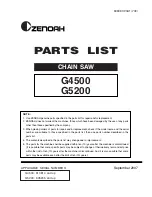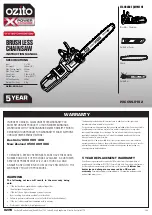
English
Français
1. For safe operation
1.Pour la sécurité
11. All chain saw service, other than the
items listed in the Owner's Manual,
should be performed by competent
chain saw service personnel. (e.g., if
improper tools are used to remove the
flywheel, or if an improper tool is used
to hold the flywheel in order to remove
the clutch, structural damage to the
flywheel could occur which could
subsequently cause the flywheel to
disintegrate).
12. Always shut oft the engine before
setting it down.
13. Use extreme caution when cutting
small size brush and saplings because
slender material may catch the saw
chain and be whipped toward you or
pull you off balance.
14. When cutting a limb that is under
tension, be alert for spring back so that
you will not be struck when the tension
in the wood fibers is released.
15. Never cut in high wind, bad weather,
when visibility is poor or in very high or
low temperatures. Always check the
tree for dead branches which could fall
during the felling operation.
16. Keep the handles dry, clean and free
of oil or fuel mixture.
17. Operate the chain saw only in well
ventilated areas. Never start or run the
engine inside a closed room or
building. Exhaust fumes contain
dangerous carbon monoxide.
18. Do not operate the chain saw in a tree
unless specially trained to do so.
19. Guard against kickback. Kickback is
the upward motion of the guide bar
which occurs when the saw chain at
the nose of the guide bar contacts an
object. Kickback can lead to
dangerous loss of control of the chain
saw.
20. When transporting your chain saw,
make sure the appropriate guide bar
scabbard is in place.
11. Toute intervention d'entretien non
décrite dans la présente notice
d'instructions doit être confiée à un
personnel d'entretien qualifié. (En
particulier, toute tentative de
démontage du volant ou de
l'embrayage sans disposer des outils
appropriés risque de fissurer le volant
qui pourrait ensuite se déslntégrer en
marche.)
12. Toujours arrêter le moteur avant de
poser la tronçonneuse.
13. Observer la plus'grande prudence en
coupant les broussailles. Une liane ou
un arbrisseau se prenant dans la
chaîne risque de faire perdre l'équilibre
ou de cingler le visage.
14. Lorsqu'on coupe une branche en
flexion, prendre garde à la détente au
moment où Ies fibres porteuses sont
sectionnées.
15. Ne coupez jamais si le temps est
mauvais, si la visibilité est insuffisante
ou si la temérature est trop basse ou
trop élevée. Assurez vous qu'il n'y a
pas de branches sèches qui puissent
tomber.
16. Maintenir la poignée et le guidon
toujours propres et secs; essuyer
immédiatement toute trace d'huile, de
graisse ou de carburant.
17. La tronçonneuse ne doit être utilisée
qu'en plein air ou dans un local bien
ventilé. Ne jamais mettre en marche
ou laisser tourner le moteur dans un
local fermé. Les gaz d'échappement
sont dangereux car ils contiennent du
monoxyde de carbone.
18. Sans entraînement spécial, s'abstenir
d'utiliser la tronçonneuse juché sur un
arbre.
19. Prendre garde au rebond,
particulièrement dangereux car la
tronçonneuse risque d'échapper des
mains. On appelle rebond le brusque
saut de la tronçonneuse lorsque la
chaîne à l'extrémité du guide-chaîne
bute contre quelque chose.
20. Pour transporter la tronçonneuse,
recouvrir la chaîne de son fourreau.
8









































